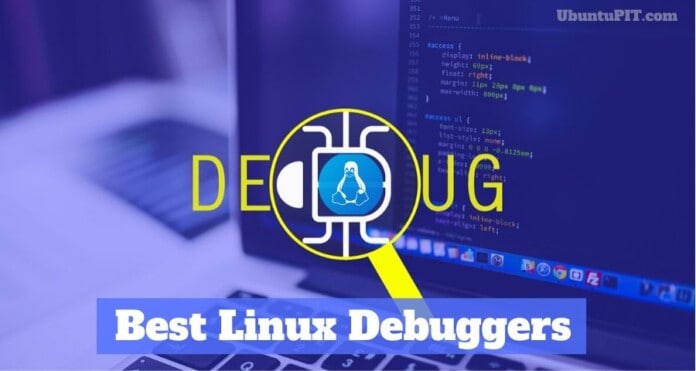Debuggers are a group of software used to analyze computer programs. They are very important from a software engineering point of view since they allow us to find problems in our code. There are several kinds of Linux debuggers, including memory debuggers, source debuggers, profilers, and so on. Common usage of these tools includes finding bugs, optimizing codebases, controlling runtime parameters, etc. Today, our editors have compiled a helpful resource outlining 20 of the best debuggers for Linux-based developers and software engineers. Take a look at them below to find out the perfect toolkit for your programming arsenal.
Best Linux Debuggers
Our picks include Linux c++ debuggers, disassemblers, PHP, and JavaScript debuggers alongside many more. Although you can find many different types of debuggers, only a few of them are useful to most developers. Luckily, you’ll be able to pinpoint the best debugger for your needs after completing this guide. So, continue reading and take a close look at the below programs.
1. GDB
GDB, aka The GNU Debugger, is arguably the best Linux debugger ever built. It was developed by the pioneer of modern open-source movement – Richard Stallman and serves as the best debugger utility to this date. The GDB is known for its portability, which allows it to run across almost every Unix-based system alongside Windows. You can easily set up breakpoints, step through code blocks, and inspect dynamic properties using GDB. Moreover, it plays very well with standard development tools like Linux code editors.
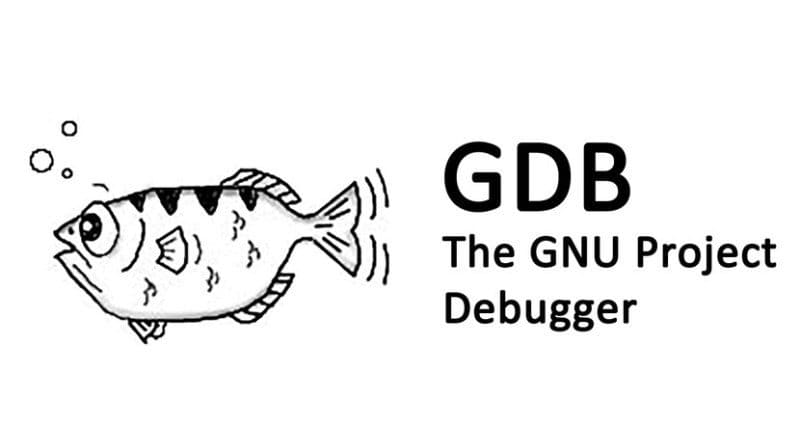
Features of GNU Debugger
- It is one of the best Linux c++ debuggers and allows developers to optimize their programs alongside patching unwanted bugs.
- GNU Debugger runs on a variety of hardware, including x86, AMD64, ARM, MIPS as well as most embedded platforms like Arduino.
- It comes with in-built support for remote debugging, which enables developers to debug programs running in another system from remote clients.
- Despite no official GUI, GDB offers seamless integration with several modern frontends like Emacs, CodeBlocks, and Qt Creator.
2. DDD
DDD or the Data Display Debugger is another excellent choice for debugging complex, modern-day software. Actually, it’s not a debugger itself, rather a frontend to several powerful debuggers such as GDB, XDB, and DBX. It is a compelling tool that allows developers to monitor running programs and offers features like machine-level debugging, hypertext navigation, debugging remote hosts, and so on. DDD is also a GNU official project. So, you can use it without encountering common problems faced in other debuggers.
Features of DDD
- DDD can be used to debug programs written in C, C++, Java, Fortran, Perl, Python, Modula, Ada, and Linux Bash scripts.
- The interactive graphical user interface is very robust and can display graphical data such as graphs and charts.
- Thanks to a massive amount of helpful resources, developers can adapt to this Linux debugger pretty easily.
- DDD also offers excellent CLI interfaces with editing, checking history, and completion abilities.
3. Interactive Disassembler
Interactive Disassembler is one of the best Linux debuggers for professional developers due to the number of features it offers. This multi-platform debugger makes it easy to maintain large-scale systems where different components run on different infrastructures. The primary selling point of this debugger is its ability to produce assembly code from compiled binary files such as standard ELF executables. However, IDA is not a free software like GDB or DDD. The developers offer multiple pricing plans, which you can view on their website.
Features of Interactive Disassembler
- IDA supports a wide variety of computing hardware, including the Intel 8086 family, ARM, DEC Alpha & PDP-11, JVM, SPARC, and PowerPC.
- It can disassemble several executable formats such as ELF, Mach-O, COFF, NE, MZ, COM, and even raw binary files.
- IDA pro comes with pre-built support for remote target debugging, code graphing, and flirt(fast library identification & recognition technology).
- The plugin-based architecture of this debugger allows it to be extended in a very short time.
4. Ghidra
Ghidra is an extremely powerful, feature-rich disassembler written by NSA researchers. It has gained immense popularity since its open-source release and facilitates compelling reverse engineering tasks. Our editors found this to be a suitable alternative to the paid IDA Pro. Ghidra is multi-platform and still being developed actively. So, even you can contribute to the project and learn to debug complex programs. Moreover, you’re guaranteed to get world-class features from a debugger written in the NSA labs.
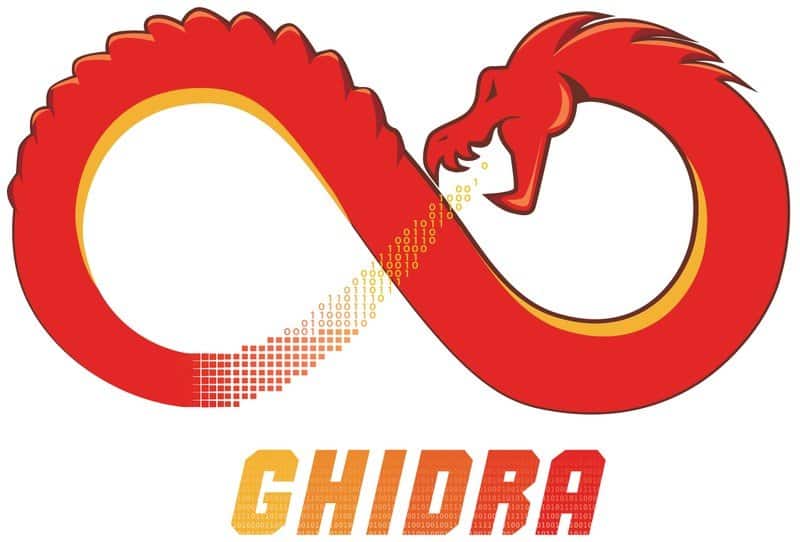
Features of Ghidra
- Ghidra comes with an astounding set of features, including assembly, disassembly, decompilation, scripting, and graphing abilities.
- Developers can run Ghidra on all major platforms and use it either interactively or via headless automation.
- The API-based architecture of this reverse engineering tool allows developers to build custom Ghidra plugins very easily.
- Ghidra is extensively customizable and supports third-party extensions written in Java, Python, or the Jython implementation.
5. Nemiver
Nemiver is a stand-alone debugger for the C and C++ programming languages. It’s a compelling project which enables developers to optimize their codebases in a practical but straightforward. Thus it has become a popular choice for Linux c++ debugger to many developers. Our editors really liked the GUI interface of this tool and suggested it heavily for starting C++ programmers. Nemiver is built for the GNOME environment and provides a backend for the GNU debugger or GDB.
Features of Nemiver
- Nemiver is exceptionally extendible and allows developers to customize the software using plugins and dynamically loaded modules.
- It provides all basic debugging features such as creating breakpoints, stepping through codes, inspecting dynamic properties, conditions, etc.
- Nemiver is written in C++ and requires very low memory, thus delivering a blazing fast debugging experience for programmers.
- It features an integrated disassembler that can be used to define automatic disassembly instructions and supports assembly mode alongside mixed sources.
6. Valgrind
Valgrind is a multi-purpose debugger that runs on Linux and other Unix-based systems and offers several features for detecting memory leaks, source debugging, and optimization. It’s written in a combination of C and Assembly, which helps it to be extremely resource-efficient. The Valgrind development team is actively working on new features and provides excellent issue tracking service. Moreover, experienced developers can build quite powerful dynamic analysis tools on top of Valgrind, thanks to its modular and opensource design.
Features of Valgrind
- Valgrind can catch any misuse of the standard POSIX Pthreads API, lock ordering problems, and data races very effectively.
- It’s essentially a Java Virtual Machine(JVM) that utilizes JIT-compilation and hosts several modular tools like Memcheck, Cachegrind, and Massif.
- The Memcheck utility detects any usage of uninitialized memory addresses, overflows, misuse of malloc, or similar dynamic allocation methods.
- Cachegrind is a capable cache profiler that provides a detailed simulation of the traditional L1, D1, and L2 caches.
7. PurifyPlus
PurifyPlus is one of the best enterprise Linux debuggers for modern-day developers due to a number of reasons. Firstly, it offers excellent features for catching dynamic memory errors like overflow, leaks, and heap misuses. It is a multi-platform software that allows memory allocation verifications and can detect problems involving operating system calls. Moreover, PurifyPlus enables developers to find many non-fatal errors. It’s a common contrast with traditional Linux C++ debuggers since they’re usually used for detecting only fatal errors.
Features of PurifyPlus
- PurifyPlus supports several advanced memory debugging features, such as pointing error locations and the size of the corrupted memory.
- Developers can easily utilize PurifyPlus for optimizing memory usage and speed up their debugging process.
- PurifyPlus highlights the potential bottlenecks of your programs and assists seamlessly in improving software speed.
- It comes with outstanding support for the integration of third-party libraries, without even requiring source access.
8. BASHDB
Shells in Linux and other Unix-like systems are so popular because they enable users to control their machines using sophisticated scripting languages. BASHDB is a compelling source-level debugger for scripts written using Bash. Our editors really liked this tool due to its simple yet practical use cases. Developers can use it to create breakpoints, trace errors, remove performance reducing bottlenecks. So, if you’re working extensively with Linux bash scripts, do not forget to check it out.
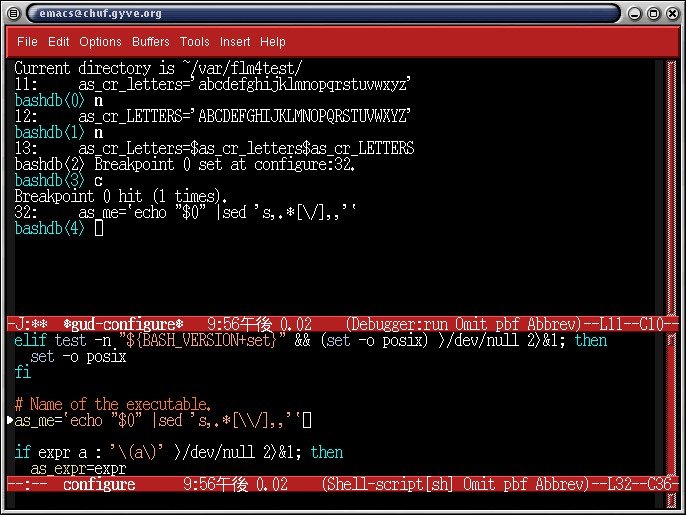
Features of BASHDB
- BASHDB is extremely resource-efficient and thus a suitable choice for debugging resource-constrained remote servers.
- The open-source GNU GPL license of this tool enables developers to modify or extend the software as they see fit.
- It comes with excellent documentation to help developers getting up and running within a few minutes.
- BASHDB enables developers to change things inside their code during runtime, allowing them to find the effect of bug fixes.
9. Bugzilla
Bugzilla is a modern-day issue tracking software that is used intensively for tracking bugs in software products. It’s not your traditional Linux debugger since it’s built to monitor bug resolving instead of tracking the bugs itself. A lot of professionals use Bugzilla to maintain their software up to date and patch future vulnerabilities. Bugzilla was developed for the Mozilla project and has proven to be a big success. Overall, it’s an excellent alternative to paid products like JIRA and Lighthouse.
Features of Bugzilla
- Bugzilla comes with robust, customizable workflow and supports Unicode, custom fields, and full-text search.
- It allows project developers to edit conflict warnings and supports LDAP-based authentication.
- Developers can control it using several interfaces such as email, command-line, GUI, and robust REST APIs.
- Bugzilla supports integration with many version control platforms, including Git, Mercurial, Bazaar, Subversion, and CVS.
10. TotalView
TotalView is a sophisticated, high-performance debugger built for analyzing complex programs. It is a well-suited tool for handling large, multi-threaded programs and can also analyze GPU clusters. TotalView is a proprietary solution and is endorsed by industry leaders like Nvidia. It integrates seamlessly with Linux applications written in C, C++, Fortran, and Python. In fact, it’s one of the best Linux C++ debuggers for developers of video games and similar resource-intensive applications. So, take a glance at this software if you’re looking for enterprise debuggers.
Features of TotalView
- TotalView allows developers to debug host and device code in a single session and provides full visibility of GPU threads in Linux.
- It can detect memory leaks, race conditions, deadlocks, etc. using complex validation methods and verified calculations.
- TotalView can debug multi-language programs more accurately than many traditional Linux debuggers.
- The reverse connects feature enables developers to debug multiple computing nodes and clusters effectively.
11. strace
strace is another compelling analysis tool used for diagnosing and debugging Linux applications. It provides an excellent userspace solution that can be used to monitor processes and manipulate interactions between processes and system calls. It is written in the C programming language, so performance should not be an issue. Moreover, strace is under active development and rolls out newer features quite frequently. It also supports path tracing and path decoding for file descriptors. So, if you’re looking for a lightweight yet full-fledged debugger, give it a try.
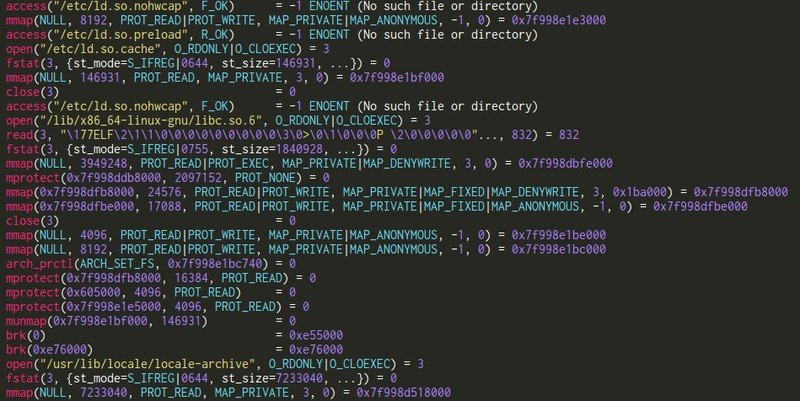
Features of strace
- strace allows developers to monitor all system calls between processes and the Linux kernel to reveal potential coding pitfalls.
- Developers can easily specify a filter of system calls alongside a list of paths for tracing and analyze execution properties.
- It allows programmers to print out stack traces, modify error codes, and inject signals based on execution flows.
- The open-source nature of strace encourages developers to extend the software as they require.
12. LLDB
LLDB is, without any doubt, one of the best Linux debuggers, you can get your hands on. It’s part of the LLVM project, which provides a robust collection of compiler and software development technologies. The LLDB debugger is a high-performance analyzer that can handle programs written in C, C++, and Objective C. It’s the default debugger component in macOS’s Xcode. LLDB tries to utilize Just in Time(JIT) techniques for expressions when supported and reverts to intermediate representation when it’s unavailable.
Features of LLDB
- Developers can use Python to access and manage the public APIs of this debugger thanks to its SWIG-based script bridging.
- The plugin-based architecture of this Linux debugger makes it easily extendible beyond everyday debugging workflows.
- LLDB allows debugging programs in remote systems using its compelling debug server component.
- This debugging toolkit comes with extensive documentation for helping kickstart your project.
13. Electric Fence
Electric Fence is a useful memory debugger for the C programming language. It can check dynamic memory allocation problems caused by methods like malloc or free. Electric Fence utilizes the virtual memory of your environment for detecting these errors and is very successful at finding stack-based buffer overflows. It works best when combined with full-fledged Linux debuggers like the GDB. Developers can simply link a program with Electric Fence’s dynamic library and inspect the program whenever a memory error occurs.
Features of Electric Fence
- Unlike many C debuggers, Electric Fence allows developers to find the exact location of memory errors.
- It causes a segmentation fault whenever a program overruns the boundary of a dynamically defined buffer.
- Electric Fence often increases program size due to the linking of its dynamic libraries to C programs.
- It is available in most Linux distros and offers ready-made packages for Ubuntu and Fedora.
14. Xdebug
Xdebug is a quite powerful debugging utility for PHP programmers. It is an extension that offers seamless debugging and profiling support. It provides numerous error detecting facilities such as stack tracing, recording function calls, and variable invocation details. Moreover, developers can easily extend the functionality of this debugger due to its open-source codebase. The software is maintained actively and releases newer features every now and then. So, if you’re a PHP developer in search of a capable debugger, keep Xdebug in your wishlist.
Features of Xdebug
- Xdebug comes with a robust, in-built profiler and offers code coverage for the PHPUnit testing framework.
- It provides stack traces for warnings, errors, notices, and exceptions as well as full parameter display for functions.
- Xdebug implements several features for checking memory allocation and offers protection for unending recursions.
- It utilizes the DBGp protocol for maintaining communication between the debugger engine and PHP IDEs for Linux.
15. KDbg
The KDbg project offers a simple yet intuitive GUI frontend for the GNU debugger. Programmers can easily create breakpoints, set conditions, step through codes, and inspect dynamic values using this tool. Our editors found this to be the ideal solution for starting programmers. However, KDbg depends on the K Desktop Environment or KDE, which is infamous for its resource usage. So, it might not be the best choice if you’re on an older, resource-constrained machine. But it’s still the best choice for beginners with little knowledge of traditional Linux debuggers.
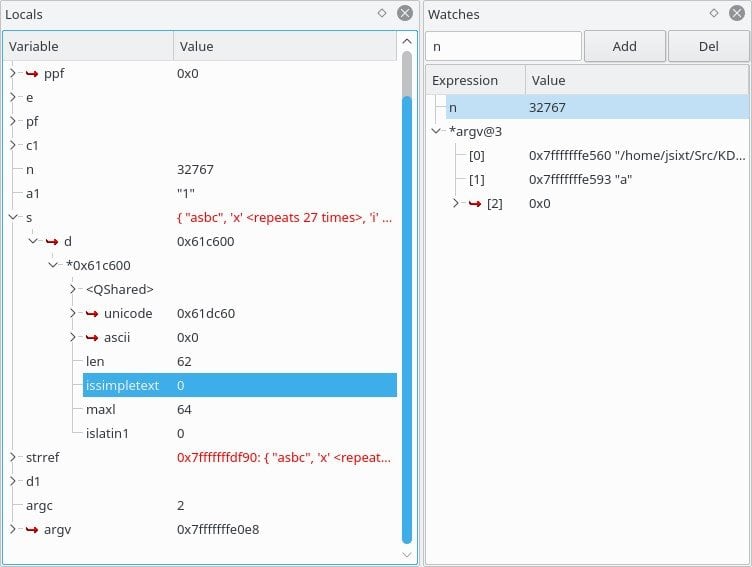
Features of KDbg
- KDbg makes debugging core dumps extremely easy and allows developers to attach running processes.
- It provides intuitive keybindings for common debugging methods like next, set, step, clear, until, and so on.
- This cross-platform debugger is quite fast but may lag in older, legacy PCs.
- KDbg comes with excellent documentation support and makes it easy to operate for beginners.
16. dbx
dbx is an old but extremely capable source-level debugger for Linux and BSD systems. It can be used to debug programs written in several programming languages, including C, ++, Fortran, Java, and Pascal. dbx allows debuggers to step one line of source code or machine instruction at a time alongside many standard functionalities like variable and expression manipulation. It was initially developed at the University of California, Berkeley, and has found its way into every major operating system since then.
Features of dbx
- It can be used for examining source codes, object files, machine instructions, core dumps, and so on.
- dbx is one of the most widely used Linux C++ compilers of the past generation and has inspired many modern alternatives.
- It utilizes symbolic variables for finding errors in executables and provide robust MVS dumps.
- dbx exposes a massive list of subcommands and a nice, intuitive GUI interface for new programmers.
17. JSwat
JSwat is a simple but productive Java debugger built on top of the Java Platform Debugger Architecture(JPDA). It’s an excellent toolkit for Java developers due to its robust feature set, which includes the ability to create conditional breakpoints, monitoring threads, system calls, and so on. Moreover, since it’s open-source software, developers can extend it to fit their projects if required. So, if you’re tired of handling monolithic Java IDEs for debugging purposes, you can try JSwat for a change.
Features of JSwat
- JSwat comes with a robust command-line interface apart from the standard GUI frontend and supports headless automation.
- It comes with a permissive CDDL(Common Development and Distribution License) license to enable further customization.
- The command-line interface exposes some additional features such as Java-like expression evaluation and method invocation.
- This software is no longer being maintained actively, but still provides a simple way to debug Java applications.
18. Affinic Debugger
The Affinic Debugger is an intuitive graphical frontend for the GNU debugger and the LLVM debugger. It aims to help developers unleash the maximum potential of their favorite Linux debuggers. Although it’s a paid software, you can get the lite version for free of charge. Moreover, the interface is pretty fast and provides an enjoyable user experience. Since you can use all the functionalities of GDB and LLDB from this debugger, it is extremely well-suited to enterprise projects.
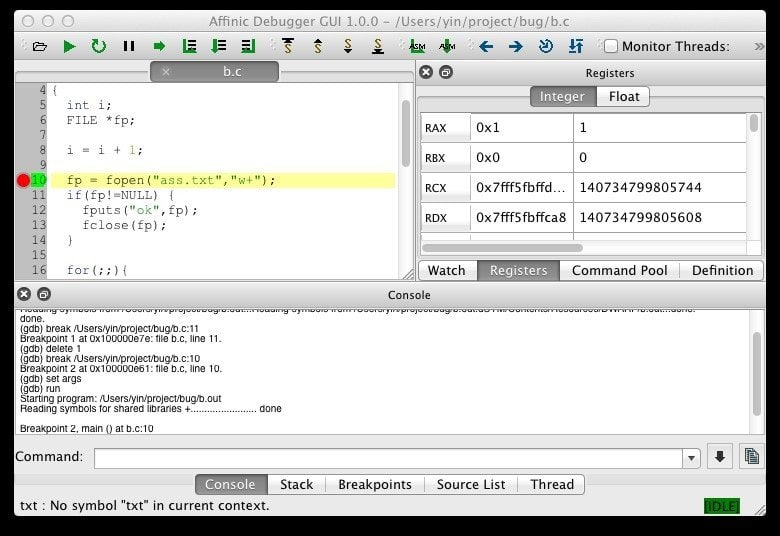
Features of Affinic Debugger
- Developers get direct access to all commonly used functionalities from the well-placed toolbars and menus.
- Affinic Debugger provides a cursor-traced printing mechanism that helps understanding codebases much faster.
- It features compelling assembly-level graphical debugging with access to multiple views, vector instructions, and so on.
- Affinic Debugger comes with in-built support for assembly to binary conversion, easy thread view, and remote debugging, among many more.
19. Insure++
Insure++ is an extremely powerful memory debugger for C and C++ programs. It features some astounding functionalities including a state of the art code parser, robust reporting methods, and hundreds of pre-built heuristics. Insure++ is aimed at professionals working in enterprise projects and offers excellent optimization support. It’s a paid software suitable for finding it hard to catch memory overflows, leaks, pointer misuse, and so on. Our editors highly recommend this debugger to developers who are looking for full-fledged enterprise products.
Features of Insure++
- Insure++ supports detecting memory leaks, buffer overflows & underflows, stack traces, and many more enterprise features.
- It can report information like bug types, problematic expressions, corrupted memory blocks, local or global stack data, and so on.
- Developers can easily visualize the contents that are creating problems or may cause future program crashes.
- It comes with excellent documentation support in the forms of professional whitepapers and manual for developers.
20. D.U.M.A
D.U.M.A or Detect Unintended Memory Access is another open-source addition to our list. It’s a compelling debugger for programs written in C and C++. This is a fork of the Electric Fence debugger with several added functionalities and can be used to perform dynamic memory checking, finding leaks, illegal memory accesses, and so on. Like Electric Fence, it also utilizes virtual level memory for detecting memory-based errors. So, take a look at D.U.M.A if you’re browsing for a capable Linux C++ debugger.
Features of D.U.M.A
- It works by overloading all traditional memory allocation methods like malloc, calloc, memalign, and their deallocation counterparts.
- D.U.M.A uses the memory management unit of the Linux kernel for protecting against illegal memory access.
- Developers can test out bug fixes without requiring to change the source or recompiling it.
- The open-source GNU GPL license sported by this tool allows seamless third-party customizations.
Ending Thoughts
Linux debuggers consist of a vital part in modern system and software development. The demand for capable debuggers is always high, and being able to handle a versatile set of debuggers is mandatory if you’re looking for high-paying computer science jobs. Since Linux offers a variety of debuggers for different purposes, beginners often find it hard to choose the appropriate solutions for them. The GNU Debugger alongside LLDB and IDA are definitely the most powerful ones you can get. However, you may also choose from a number of tools built for solving language or system-specific programming problems such as strace.
